![]()
![]()
![]()
Use LEFT and RIGHT arrow keys to navigate between flashcards;
Use UP and DOWN arrow keys to flip the card;
H to show hint;
A reads text to speech;
55 Cards in this Set
- Front
- Back
|
Theory |
-aim to bing together -in a systematic fashion- knowledge about some particular aspect of the world or experience -general statement about logical relationships between variables to explain a class of phenomena -descriptive in nature and promotes understanding -function is to help make predictions |
|
|
Inductive reasoning |
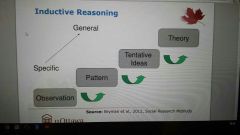
Specific to general |
|
|
Deductive reasoning |
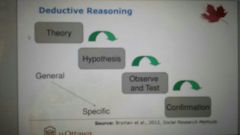
General to specific |
|
|
Development science |
Attempts to explain the underlying processes if development and aging (the "why") VS. simply describing changes over time as people get old (the "what") |
|
|
Nature - nurture debate |
Nature: people proceed through life stages based on genetics and inherited traits Nurture: based on life circumstances and how the environment shapes the course of their lives (e.g., "social determinants of health") |
|
|
Life span perspective |
Development is continuous from childhood to old age |
|
|
Contextual influences |
Life span changes is a function of nature and nurture |
|
|
Development science |
Need to look at multiple factors in development |
|
|
Organismic model |
Nature drives development |
|
|
Mechanistic model |
Nurture drives development |
|
|
Reductionist vs Holistic views |
Breaking down the person into small, fundamental units or parts for study and treatment VS recognizing the interdependence of various bodily systems, including the body, mind, and spirit |
|
|
Interactionist model |
Genetics, the environment, and individual participation in development interact in complex ways to inform development -multi-directionality -multi-dimensionality -plasticity |
|
|
The environment includes those context and conditions which occur outside individuals and have the probability of ..... |
influencing the individual and eliciting responses from them |
|
|
The environment is a _______, _________ which ranges from physical features TO specific proximal transaction |
Multilevel, multidimensional hierarchical system |
|
|
The environemnt operates not only in...... |
Space (objective environemnt) and within the individual (subjective environemnt), but also across time (temporal environemnt) |
|
|
Adults both ______ and are _______ by their environemnt |
Shape and are shaped |
|
|
Components of the environemnt which influence psychological aging |
Physical (ex: architecture, natural environment, products and technology) Social or psychosocial (ex: family, peers) Cultural (ex: norms, values, beliefs) Institutional (ex: services, hospitals, community organizations) Legal (ex: laws, regulations) Political (ex: government, systems) Economic (ex: assistance, policie) Temporal (ex: time patterns and rhythms) |
|
|
Transactional approach |
Assumes an interdependence of the person and the environemnt Recognized that a person's context are continually shifting and as contexts change, the behaviour necessary to accomplish a goal also changes |
|
|
Environmental press |
The environment exerts a press -physical,interpersonal, or social forces or demands- upon the person, which is either supportive (e.g., facilitating) or challenging (e.g., inhibiting) |
|
|
Environmental press theory |
A theory of adaptation that focuses on person variables (competencies), environmental variables (environmental press), and the interaction between the two variables |
|
|
Environmental press zones |

|
|
|
Bronfenbrenner's ecological system theory |

|
|
|
Microsystem |
The immediate surroundings of the person (e.g., family,workplace,peers, neighborhood) in which the most direct interactions with social agents occur |
|
|
Mesosystem |
The connections between different microsystems or context (e.g., family and school) |
|
|
Exosystem |
The connection between a social setting in which a person does not have an active role and the persons immediate context (e.g., older adult depending in the adult child for care --> older adults interactions with the adult child are affected by the adult child's job or place of employment) |
|
|
Macrosystem |
The culture and society in which a individuals live (e.g., norms, laws, socioeconomic status) |
|
|
Chronosystem |
The persons socio-historical conditions, pattern of environemnt events and transitions over life (e.g., transition to retirement, challenging life events, new job) |
|
|
Bonfenbrenner's ecological perspective |
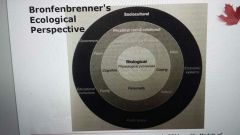
|
|
|
Different Cultural environemnt |
May be significant variation in how mainstream and different ethnic populations define or address aging, the concerns regarding aging, and the solutions that are proposed Cultural beliefs and attitudes determine behaviours, guide decisions, and effect interactions with society People develop a mix of cultural roles, expectations, ideologies that determine how it's members view social networks, support systems, and communities |
|
|
Culture |
The learned and shared way of life, traditions, values, beliefs, norms, dress, language, artifacts, attitudes, behaviours and knowledge that create a describable pattern in the lives of groups of people or communities |
|
|
Culture deals with |
1. Actions of people (cultural behaviour) 2. Knowledge of people (cultural knowledge) 3. Objects or resources people create and use (cultural artifacts) |
|
|
Static perspective of culture |
Culture is considered a representative picture of an ethnic group (e.g., lifestyle, traditions, rituals); people are subjected to cultural traits and become passive recipients of such characteristics |
|
|
Dynamic perspective of cultural |
Culture is viewed as learned patterns of behaviour or shared perceptions among people; people become active learners about their cultures |
|
|
In practice, when developing and implementing interventions, it may be best to .... |
-view culture as a series of "guiding mechanisms" (e.g., rules, norms and strategies) that direct behaviour and thought, rather than complex and concrete patterns of behaviour (e.g., customs and traditions) -investigate cultural processes and how particular groups associate and negotiate to respond to human problems (e.g., exclusion of aging persons; lack of resources for the elderly) |
|
|
Multiculturalism in Canada |
Refers to the presences and persistence of divers racial and ethnic minorities who define themselves as different and who wish to remain so. Ideologically, multiculturalism consists of relatively coherent set of ideas and ideals pertaining to the celebrating of Canada's cultural mosaic. Multiculturalism at the policy level is structured around the management of diversity through formal initiatives in the federal, provincial and municipal domains. Finally,multiculturalism is the process by which racial and ethnic minorities compete with central authorities for achievement of certain goals and aspirations |
|
|
Life course perspective |
Social scientists distinguished life "course" from life "span" in order to emphasize the non-biological factors that influences changes over time Attempt to link social factors to individual adaptation |
|
|
Occupation |
The sum of all meaningful activities that an individual has a need or desire to pursue, including activities for personal care and growth, productivity (school/work), and leisure |
|
|
Life span (image) |
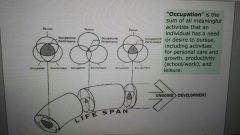
|
|
|
Person- Environemnt fit (PE) theory |
Offers a framework for assessing and predicting how characteristics of the person and environemnt together will determine wellbeing |
|
|
Fit |
Has been described as a usable environemnt that matches the persons abilities with appropriate support |
|
|
Psychosocial factors |
Impinge on the definition fit (e.g., self-image, motivation, social pressure, and expectations) |
|
|
The objective of interventions may be to ensure societal participation through environmental design, modification, or adaptation, with the aim to improve the __________ |
Person - Environemnt fit |
|
|
Disengagement theory |
Claims that normal and natural evolution of life results in older adults desire to loosen their social ties; retirement and social isolation are circumstances that older adults wish and benefit from |
|
|
Activity theory |
View that older adults would rather be involved and not forced out if productive roles, and prefer to remain active |
|
|
Continuity theory |
Proposes that whether disengagement of activity is beneficial to the older adults depends on individuals personality; inclusion in or exclusion from social roles and actives should be consistent with ones will and desire |
|
|
Sucessful aging |
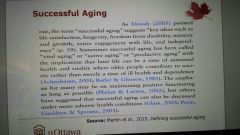
|
|
|
Sucessful aging definitions |
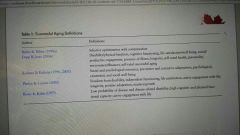
|
|
|
Erikson's Psychosocial Theory |
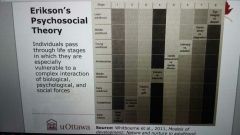
Individuals pass through life stages in which they are especially vulnerable to a complex interaction of biological, psychological, and social forces |
|
|
Erikson psychological theory : identity achievement vs identity diffusion |
Clear identity and coherent sense of self, purpose, and direction VS unclear sense of self, vagueness about life's purpose, and lack of direction |
|
|
Erikson's psychosocial theory : intimacy vs isolation |
Establishing a mutually satisfying close relationship (lifelong commitment) with another person VS never achieving true mutuality life partner |
|
|
Erikson's psychosocial theory : generativity VS stagnation |
Focuses on psychosocial issues of procreation/parenthood, productivity, creativity, and concern for next generation VS concern only for self and/or ones age group |
|
|
Erikson's psychosocial theory : ego integrity vs despair |
Those who establish a strong sense of self can look back at their experiences and inevitability of death with acceptance VS realization that death is unavoidable and will come soon with little/ no time to make previous wrongs rights |
|
|
Identity process theory |

|
|
|
Ottawa Charter on Health Promotion uses ______________ as a foundation for its recommendation |
Socio-ecological framework |
|
|
In the US Convention on the Rights of Persons with Disabilities, disability is defined through .... |
An ecological model in which disability is seen as an evolving concept reflecting the interaction between the individual and social attitude and the physical, economic and political environemnt that hinders the full and equal participation of persons with disability in society |

